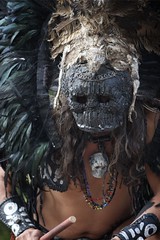Have You Experienced The Alaskan Native Culture?
In downtown Juneau, tourists can see a wall sculpture of Chief Kowee, head of the Auk Tlingits tribe. In the 1800s, he guided prospectors Joe Juneau and Rihard Harris to a reservoir of gold along Alaska’s southeast Gastineau Channel. Asking only for Hudson Bay blankets and small compensation, Chief Kowee was a great ally to the Europeans and later served in the Alaskan native police force.
Over the coming years, the town of Juneau sprung up and thousands of gold prospectors flooded the Yukon to find their fortune. If you go on an Alaskan vacation and take a White Pass train ride, then you can still see the remnants of historic mines and evidence of optimism and the quest for the American dream.
A good starting point to learn more about Alaska’s indigenous people is to visit The Alaska Native Heritage Center in Anchorage Alaska. This world renowned cultural center and museum contains information, educational materials, video presentations, artwork and displays documenting the following Alaskan native peoples: the Athabascan, the Aleut & Alutiiq, the Yup’ik & Cup’ik, the Inupiaq & St. Lawrence Island Yupik, the Eyak, the Tlingit, the Haida and the Tsimshian.
Here you can view beaded artwork from the Athabascan people, learn about the spirituality of the Yup’ik and Cup’ik, who believed in good shamans for healing and bad shamans who placed curses on people, or gaze upon the festive Chilkat & raven’s tail robe regalia worn at the Eyak potlach festivals.
Fairbanks Alaska is a good launching place for learning more about the Alaskan native peoples. The annual Native Arts Festival in February brings together artwork, crafts, dance and folklore. In
Pages: 1 2
